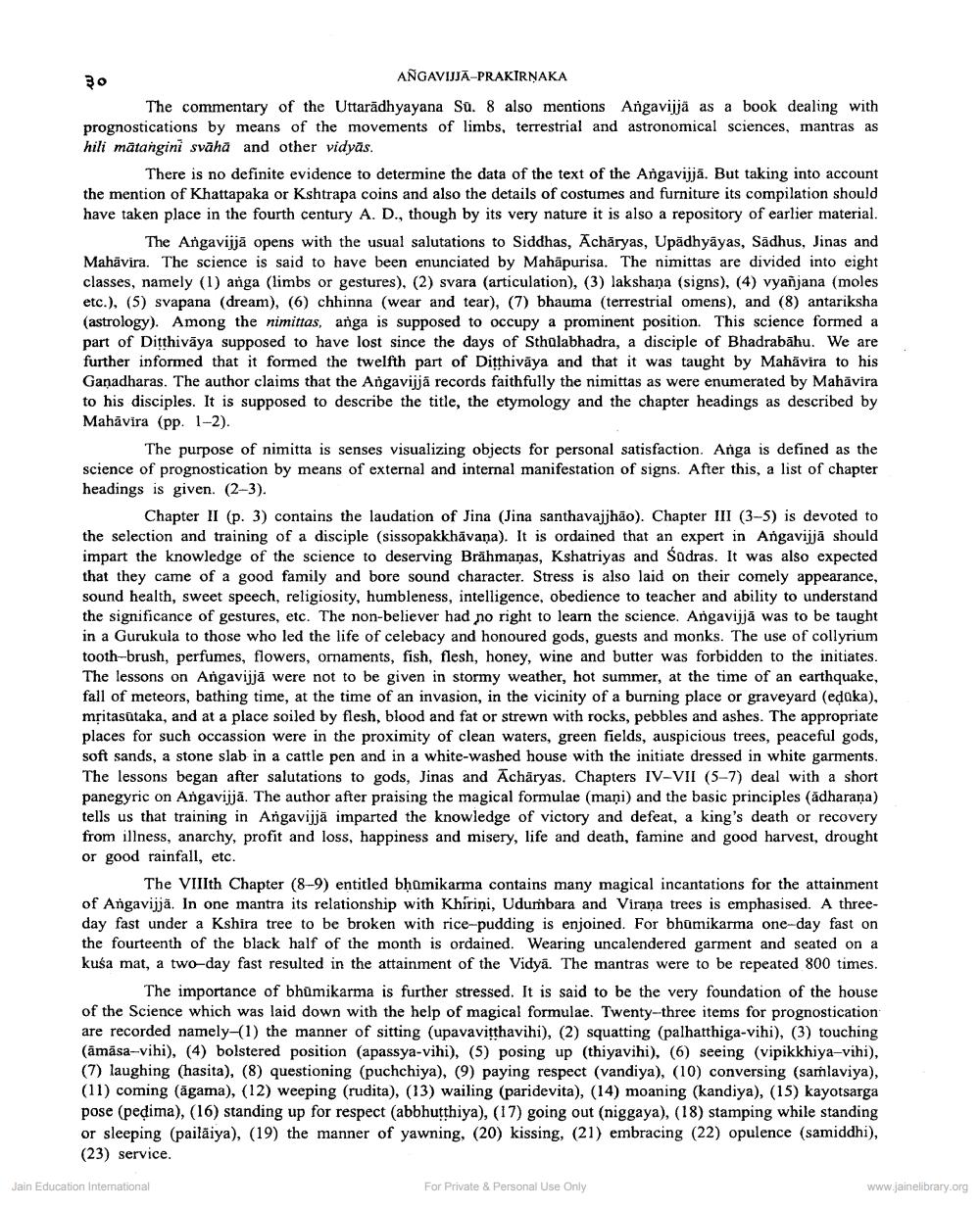________________
३०
ANGAVIJJA-PRAKIRŅAKA The commentary of the Uttarādhyayana Su. 8 also mentions Angavijjä as a book dealing with prognostications by means of the movements of limbs, terrestrial and astronomical sciences, mantras as hili mätangini svāha and other vidyas.
There is no definite evidence to determine the data of the text of the Angavijjā. But taking into account the mention of Khattapaka or Kshtrapa coins and also the details of costumes and furniture its compilation should have taken place in the fourth century A. D., though by its very nature it is also a repository of earlier material.
The Angavijjā opens with the usual salutations to Siddhas, Achāryas, Upadhyāyas, Sadhus, Jinas and Mahāvira. The science is said to have been enunciated by Mahāpurisa. The nimittas are divided into eight classes, namely (1) arga (limbs or gestures), (2) svara (articulation), (3) lakshana (signs), (4) vyañjana (moles etc.), (5) svapana (dream), (6) chhinna (wear and tear), (7) bhauma (terrestrial omens), and (8) antariksha (astrology). Among the nimittas, anga is supposed to occupy a prominent position. This science formed a part of Ditthivāya supposed to have lost since the days of Sthalabhadra, a disciple of Bhadrabāhu. We are further informed that it formed the twelfth part of Ditthivāya and that it was taught by Mahāvira to his Ganadharas. The author claims that the Angavijjá records faithfully the nimittas as were enumerated by Mahavira to his disciples. It is supposed to describe the title, the etymology and the chapter headings as described by Mahavira (pp. 1-2).
The purpose of nimitta is senses visualizing objects for personal satisfaction. Anga is defined as the science of prognostication by means of external and internal manifestation of signs. After this, a list of chapter headings is given. (2-3).
Chapter II (p. 3) contains the laudation of Jina (Jina santhavajjhão). Chapter III (3-5) is devoted to the selection and training of a disciple (sissopakkhāvana). It is ordained that an expert in Angavijjā should impart the knowledge of the science to deserving Brāhmanas, Kshatriyas and Sadras. It was also expected that they came of a good family and bore sound character. Stress is also laid on their comely appearance, sound health, sweet speech, religiosity, humbleness, intelligence, obedience to teacher and ability to understand the significance of gestures, etc. The non-believer had no right to learn the science. Angavijjā was to be taught in a Gurukula to those who led the life of celebacy and honoured gods, guests and monks. The use of collyrium tooth-brush, perfumes, flowers, ornaments, fish, flesh, honey, wine and butter was forbidden to the initiates. The lessons on Angavijjā were not to be given in stormy weather, hot summer, at the time of an earthquake, fall of meteors, bathing time, at the time of an invasion, in the vicinity of a burning place or graveyard (eďaka), mritasutaka, and at a place soiled by flesh, blood and fat or strewn with rocks, pebbles and ashes. The appropriate places for such occassion were in the proximity of clean waters, green fields, auspicious trees, peaceful gods, soft sands, a stone slab in a cattle pen and in a white-washed house with the initiate dressed in white garments. The lessons began after salutations to gods, Jinas and Acharyas. Chapters IV-VII (5-7) deal with a short panegyric on Angavijja. The author after praising the magical formulae (mani) and the basic principles (adharana) tells us that training in Angavijă imparted the knowledge of victory and defeat, a king's death or recovery from illness, anarchy, profit and loss, happiness and misery, life and death, famine and good harvest, drought or good rainfall, etc.
The VIIIth Chapter (8-9) entitled bhumikarma contains many magical incantations for the attainment of Angavijja. In one mantra its relationship with Khirini, Udumbara and Virana trees is emphasised. A threeday fast under a Kshira tree to be broken with rice-pudding is enjoined. For bhūmikarma one-day fast on the fourteenth of the black half of the month is ordained. Wearing uncalendered garment and seated on a kuśa mat, a two-day fast resulted in the attainment of the Vidyā. The mantras were to be repeated 800 times.
The importance of bhumikarma is further stressed. It is said to be the very foundation of the house of the Science which was laid down with the help of magical formulae. Twenty-three items for prognostication are recorded namely-1) the manner of sitting (upavavitthavihi), (2) squatting (palhatthiga-vihi), (3) touching (āmāsa-vihi), (4) bolstered position (apassya-vihi), (5) posing up (thiyavihi), (6) seeing (vipikkhiya-vihi), (7) laughing (hasita), (8) questioning (puchchiya), (9) paying respect (vandiya), (10) conversing (sarlaviya), (11) coming (agama), (12) weeping (rudita), (13) wailing (paridevita), (14) moaning (kandiya), (15) kayotsarga pose (peļima), (16) standing up for respect (abbhutthiya), (17) going out (niggaya), (18) stamping while standing or sleeping (pailäiya), (19) the manner of yawning, (20) kissing, (21) embracing (22) opulence (samiddhi), (23) service.
Jain Education International
For Private & Personal Use Only
www.jainelibrary.org




